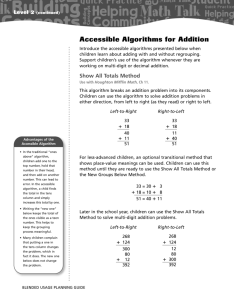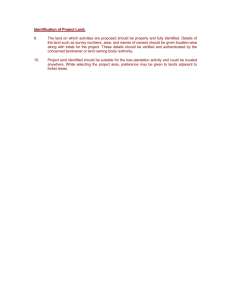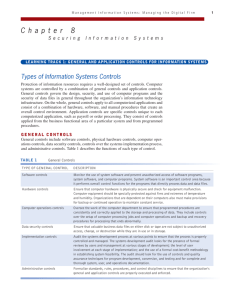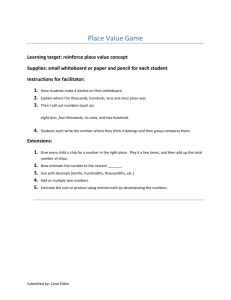2nd Grade Math Lesson: Totals Below Addition Method
advertisement
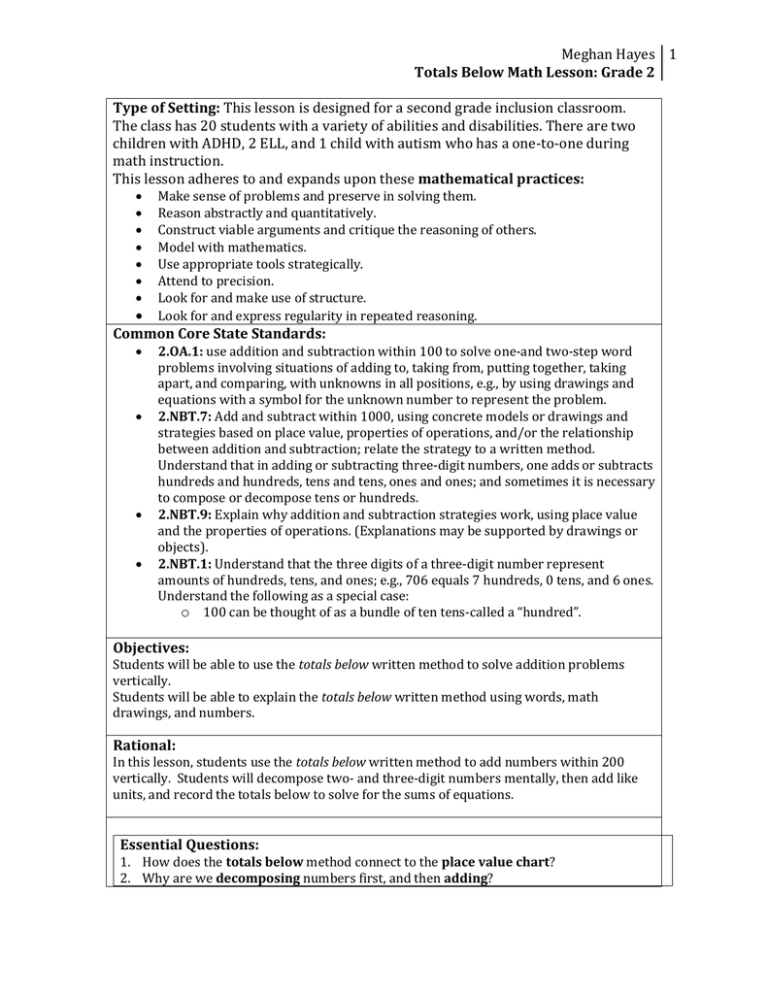
Meghan Hayes 1 Totals Below Math Lesson: Grade 2 Type of Setting: This lesson is designed for a second grade inclusion classroom. The class has 20 students with a variety of abilities and disabilities. There are two children with ADHD, 2 ELL, and 1 child with autism who has a one-to-one during math instruction. This lesson adheres to and expands upon these mathematical practices: Make sense of problems and preserve in solving them. Reason abstractly and quantitatively. Construct viable arguments and critique the reasoning of others. Model with mathematics. Use appropriate tools strategically. Attend to precision. Look for and make use of structure. Look for and express regularity in repeated reasoning. Common Core State Standards: 2.OA.1: use addition and subtraction within 100 to solve one-and two-step word problems involving situations of adding to, taking from, putting together, taking apart, and comparing, with unknowns in all positions, e.g., by using drawings and equations with a symbol for the unknown number to represent the problem. 2.NBT.7: Add and subtract within 1000, using concrete models or drawings and strategies based on place value, properties of operations, and/or the relationship between addition and subtraction; relate the strategy to a written method. Understand that in adding or subtracting three-digit numbers, one adds or subtracts hundreds and hundreds, tens and tens, ones and ones; and sometimes it is necessary to compose or decompose tens or hundreds. 2.NBT.9: Explain why addition and subtraction strategies work, using place value and the properties of operations. (Explanations may be supported by drawings or objects). 2.NBT.1: Understand that the three digits of a three-digit number represent amounts of hundreds, tens, and ones; e.g., 706 equals 7 hundreds, 0 tens, and 6 ones. Understand the following as a special case: o 100 can be thought of as a bundle of ten tens-called a “hundred”. Objectives: Students will be able to use the totals below written method to solve addition problems vertically. Students will be able to explain the totals below written method using words, math drawings, and numbers. Rational: In this lesson, students use the totals below written method to add numbers within 200 vertically. Students will decompose two- and three-digit numbers mentally, then add like units, and record the totals below to solve for the sums of equations. Essential Questions: 1. How does the totals below method connect to the place value chart? 2. Why are we decomposing numbers first, and then adding? 3. We have been adding the ones first, and the tens second. Would we get the same answer if we added the tens first, and the ones second? Performance Based Assessment Questions: 1. Can you show me how to write the number 11 in the say ten way? 2. Can you complete this number sentence: 82= ________ tens and ______ ones. 3. Solve 106 +24 vertically using the totals below method. Draw a place value chart with disks to represent and check your work. Do Now: (Review of place value) Problem of the dayThe following will be written on the board for students to complete: Please draw a place value chart with disks to represent the number 127. Set Induction: The students will complete a math sprint, a worksheet composed of ten number sentences that requires them to rename the units of numbers within a two-minute time frame. For example, question 1 is written as: 45 =__________ tens and _______ ones. This fluency activity reviews foundations required in the day’s lesson, decomposing numbers into expanded form to recognize place value, which will aid in adding like units to find the sum of addition equations. Then I will introduce the totals below method to the class. Procedure: Tell students: Today we will be learning the totals below method to solve vertical addition problems. This involves decomposing the two numbers in the addition problem into like units, tens and ones. Then you add from right to left, meaning add the ones together first, and the tens together second to solve for the sum of the equation. Read and model how to solve a problem on the smartboard (or chalk/whiteboard) using totals below: Let’s look at this vertical addition problem together: 23 + 48 ____________ You have been solving vertical addition equations for some time now. Someone remind me, in which direction do we move when solving for the sum of the equation? (expected response is right to left). You will move in the same direction when using the totals below method. That means we add the 3 and 8 together first. What place is the 3 in in the number 23? What about the 8 in 48? (the ones place). What does 8 +3 = ? Write it on the board as such: 23 + 48 ____________ 11 What place is the 2 in in the number 23? What about the 4 in 48? (the tens place). That means you are really adding 20 and 40 together, which makes? Write it on the board as Meghan Hayes 3 Totals Below Math Lesson: Grade 2 such: 23 + 48 ____________ 11 60 When solving, you write the totals of each like unit you add together below the original equation. Then you solve for the final sum of the equation by adding those two totals together. 60 + 11 = 71. Tell students: Once you have solved for the sum of the equation, you can create a place value chart for each number to check your work. (proceed to model this for the above addition equation). Guided Practice: The teacher and students will work together to solve another vertical addition equation on the board using the totals below method. The students will model the work on their individual white boards. Read and discuss the problem: how can we decompose these numbers to add like units together and solve for the sum of the equation? Ask students to turn and talk. You can separate the numbers into tens and ones, and add the totals of those like terms together to solve for the sum of the original equation. 45 + 37 ____________ 12 (5 + 7) 70 (40 + 30) _____________________ 82 This connects to the learning model. Reinforce the importance of writing the totals of each like unit below the original equation. You are creating easier visual numbers to add together. Students will complete a third exercise to check for understanding. If they correctly complete exercise 3, they can move onto the independent practice. Independent Practice/Tiered Groups: Each group has been given the same independent worksheet to complete, but will use certain tools to help them when solving the addition equations. Group 1 (High): Draw the chip model to represent the place value chart when checking the work you created using the totals below method. No prompting or manipulatives needed. Group 2 (Intermediate): Students will use manipulatives (place value chips) to create the place value chart when checking the work they’ve done using the totals below method. Questions asked to prompt thinking are: How did you decide how many chips went under each column (hundreds, tens, ones)? Is the total on the place value chart equal to or different than the total you originally found using the totals below method? Group 3 (Low): Students will work in a one-on-one setting with Mrs. C (math resource room teacher who pushes in). Students will use manipulatives (place value chips) to create the place value chart when checking the work they’ve done using the totals below method. A correctly labeled place value chart will be located at their workstation to use as a visual reference when constructing their place value charts to check work. Questions asked to prompt thinking are: How should we label each column in the place value chart? How did you decide how many chips went under each column (hundreds, tens, ones)? Is the total on the place value chart equal to or different than the total you originally found using the totals below method? All students can use the manipulatives for visual representation if needed. Even though Mrs. C is working with the low group, I am also available for one-on one time/support with students. ELL support- the math vocabulary words related to the lesson have been added to the word wall in the classroom. Pictures/symbols have also been added next to the words to describe the vocabulary word further. For example, next to the word sum, there is a picture of the equation two flowers +two flowers = four flowers. The four flowers are circled to show it’s the sum! Closure: Students will complete an exit ticket that reinforces the totals below method taught today. (see attached worksheet). This will be collected and their responses will be evaluated. Vocabulary: Materials: Review- sum, decompose, like units (addends), place value, tens, ones, and hundreds New- totals below, equation, separate (synonym for decompose) Homework: Students will be given a worksheet to complete at home. (see attached). The worksheet is further practice with the totals below addition strategy. White boards Dry erase markers Pencils Math sprint wkshts Ext ticket wkshts Independent practice wkshts Place value charts Place value chips (already labeled) SmartBoard Assessment Strategies: Teacher Observation Oral Responses Individual Practice Guided Practice Performance Tasks Resources: Inspiration behind this lesson, Grade 2 Math Module 4 from engageny: http://www.engageny.org/sites/default/files/resource/attachments/math-g2-m4full-module.pdf (pgs. 352-361) Place Value Disks and Chart for the Smartboard: http://exchange.smarttech.com/details.html?id=8cd88c08-522c-4984-bf99c01f9dd49ba3 Meghan Hayes 5 Totals Below Math Lesson: Grade 2 Parent Handbook to the Grade 2 Math Module 4: http://moodle.smithtown.k12.ny.us/pluginfile.php/38461/mod_resource/content/ 1/Parent%20Handbook%20Grade%202%20Module%204.pdf Additional place value worksheets: http://www.mathworksheets4kids.com/activities/2nd-grade.html Totals below extension activity: http://www.eduplace.com/math/mthexp/g2/algorithms/pdf/aa_g2_02.pdf Totals Below math video: http://www.youtube.com/watch?v=wU8WwVLe0yM


